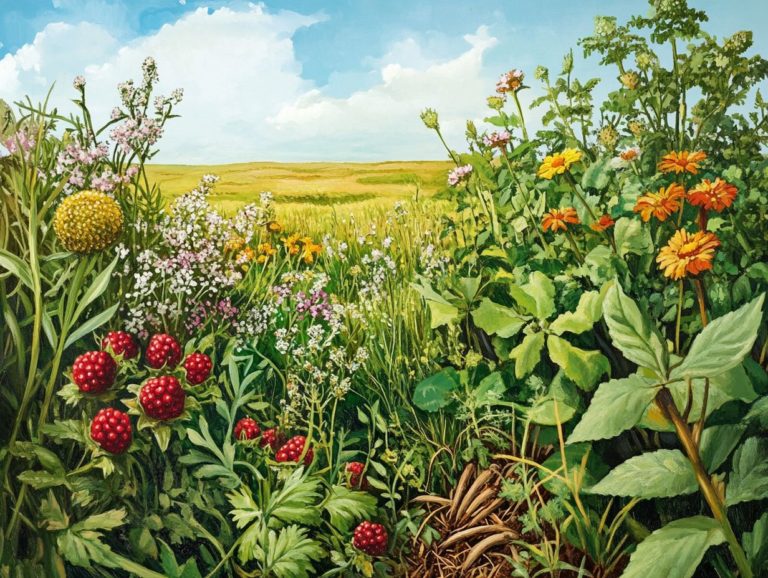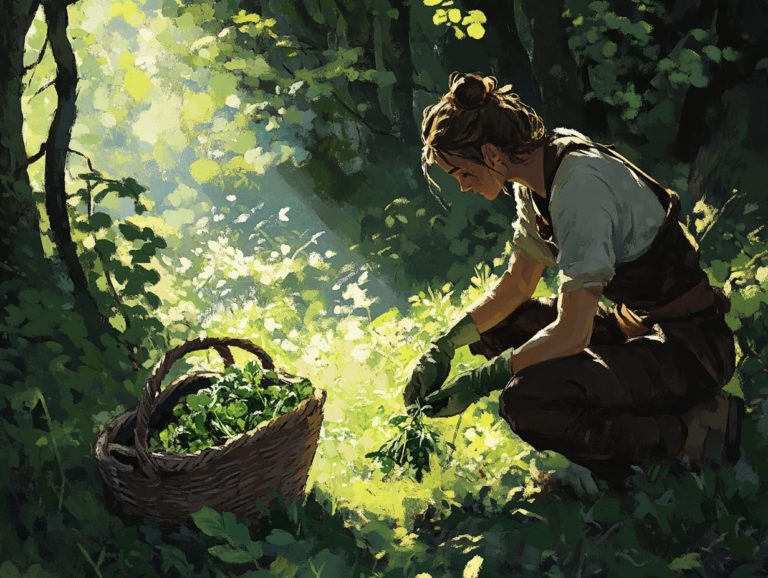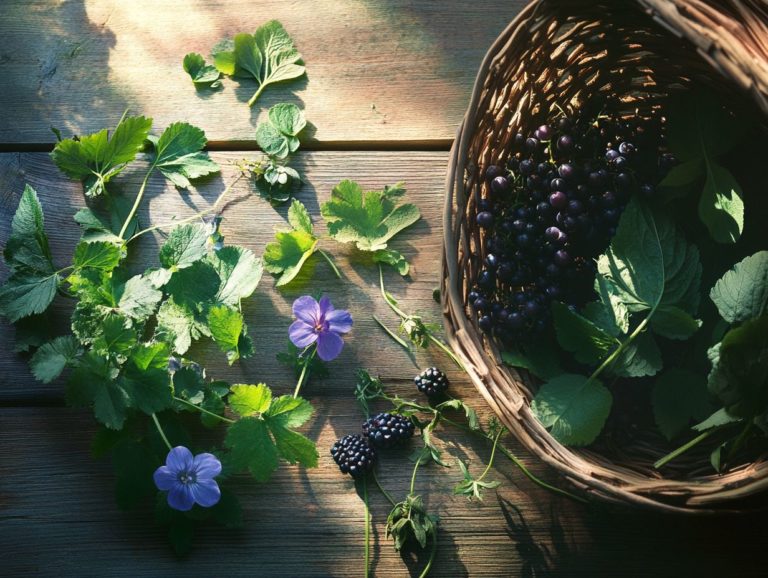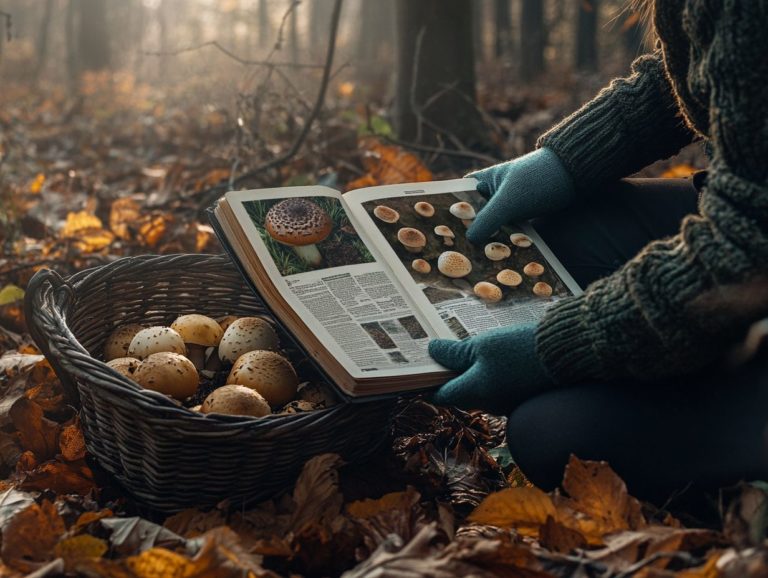Top 10 Wild Fungi You Can Eat
Wild mushrooms and other edible varieties are not just a culinary delight; they are packed with flavors and health advantages waiting to be uncovered.
Here, you will discover the top 10 wild edible mushrooms. Each one offers unique tastes and textures that can make your cooking more exciting, from button mushrooms to shiitake mushrooms.
You ll find many health benefits to integrating these fascinating fungi into your diet, including medicinal mushrooms. Along with expert tips for safe mushroom identification and harvesting, you ll also learn about potential risks and enjoy mouthwatering mushroom recipes.
Get ready to dive into the amazing world of wild mushrooms!
Contents
- Key Takeaways:
- 1. Morel Mushrooms
- 2. Chanterelle Mushrooms
- 3. Porcini Mushrooms
- 4. Hen of the Woods
- 5. Lion’s Mane Mushrooms
- 6. Oyster Mushrooms
- 7. Chicken of the Woods
- 8. Black Trumpet Mushrooms
- 9. Lobster Mushrooms
- 10. Puffball Mushrooms
- What Are Wild Edible Mushrooms?
- What Are the Health Benefits of Eating Wild Fungi?
- How Can One Safely Identify and Harvest Wild Mushrooms?
- What Are the Potential Risks of Eating Wild Mushrooms?
- How Can One Incorporate Wild Mushrooms into Their Diet?
- What Are Some Delicious Recipes Using Wild Mushrooms?
- What Are Some Common Myths About Eating Wild Fungi?
- Frequently Asked Questions
- What are the top 10 wild fungi that are safe to eat?
- Are all wild fungi safe to eat?
- What is the best way to harvest wild fungi for consumption?
- Are there any precautions to take when foraging for wild fungi?
- Can wild fungi be cooked in the same way as store-bought mushrooms?
- What are the health benefits of consuming wild fungi?
Key Takeaways:
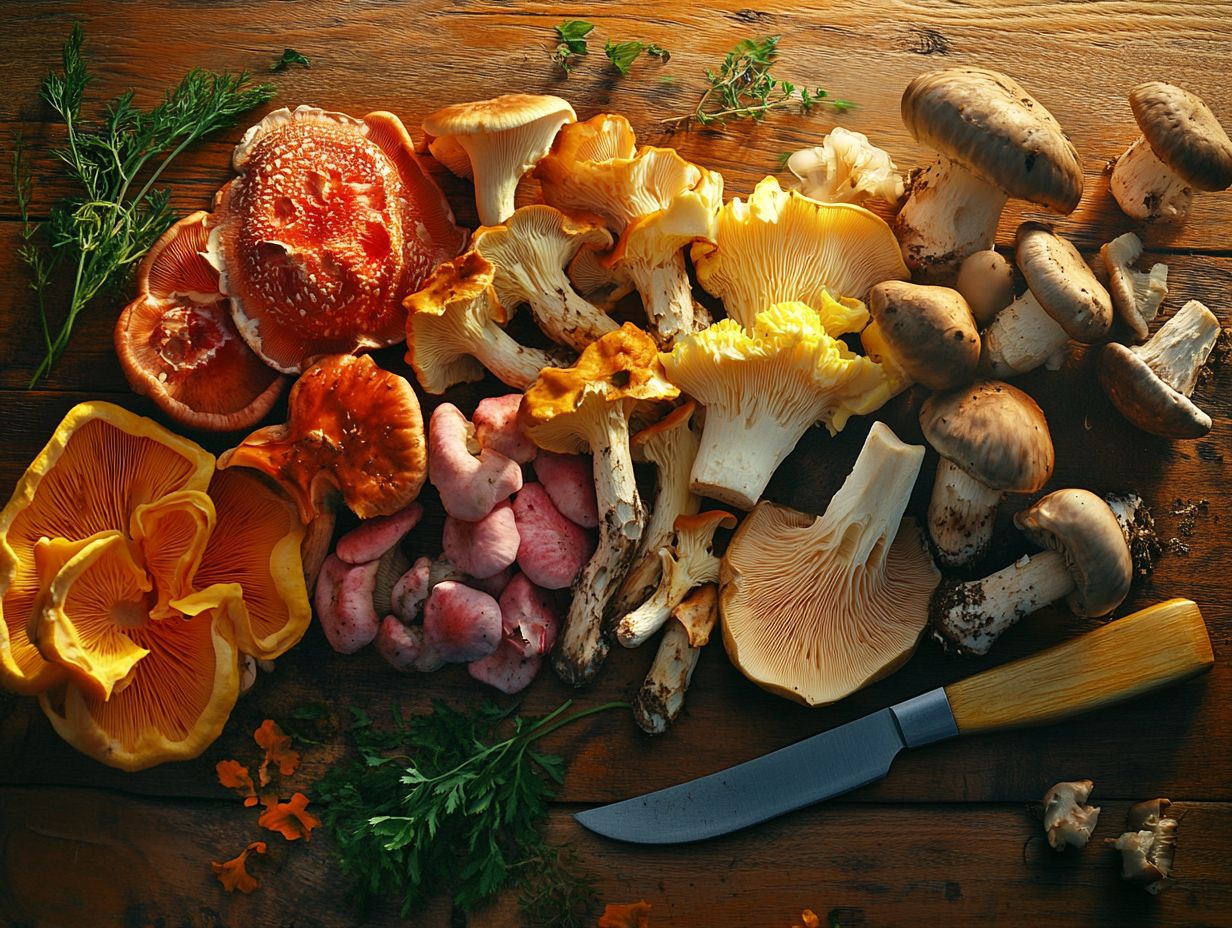
- Expand your culinary horizons with these top 10 wild fungi and gourmet mushrooms that are delicious and packed with health benefits.
- Safely incorporate wild mushrooms into your diet for a unique and nutritious experience with proper identification and harvesting techniques.
- Educate yourself on the potential risks of foraging mushrooms to enjoy the flavors and textures of wild edible mushrooms in various recipes.
1. Morel Mushrooms
Morel mushrooms are a prized delicacy in the culinary world. Renowned for their distinct flavor and versatility, they are a favorite among gourmet chefs and food enthusiasts.
These elusive fungi often flourish in wooded areas, particularly during the spring months in regions like Long Island, New York. Their distinctive honeycomb appearance helps identify them and adds charm to various dishes, showcasing their health advantages, like boosting your immune system and providing important vitamin D.
You ll find morels thriving in rich, moist soil, typically around trees like elm, oak, and ash. When foraging, look for their unique cap shape adorned with a mesh-like surface and signs of recent rainfall or forest decay.
In the kitchen, morels shine when saut ed in butter, blended into creamy sauces, or featured in a luscious risotto, often complemented by other mushrooms like shiitake or portobello. Their earthy flavor elevates any dish, offering health benefits such as supporting immune function and supplying essential minerals.
For a memorable meal, try recipes like morel-stuffed chicken or pasta with a tantalizing morel cream sauce, featuring a combination of mushrooms, including cremini and oyster. These delights will truly showcase the exquisite taste and texture of these remarkable mushrooms.
2. Chanterelle Mushrooms
Chanterelle mushrooms are among the most coveted edible treasures. Known for their stunning golden hue and exquisite flavor, they elevate any dish they touch, making them a favorite among culinary enthusiasts.
These vibrant fungi not only enhance the visual appeal of your plates but also deliver a unique blend of earthy and fruity notes. They transform even the simplest meals into extraordinary culinary experiences. Nutritionally, they are low in calories while being rich in vitamins D and B, along with essential minerals like potassium and copper.
Whether you saut them in butter to highlight their nuanced flavors or incorporate them into risottos, pasta, and soups, chanterelle mushrooms offer endless possibilities. They re a versatile choice that shines in both rustic and refined dishes.
3. Porcini Mushrooms
Porcini mushrooms are truly a culinary treasure among various mushroom varieties. They are celebrated for their rich, earthy flavor and meaty texture. If you re a chef or a home cook looking to elevate your dishes, these mushrooms are your secret weapon.
You ll often find them starring in Italian recipes, where their robust flavor perfectly complements pasta, risottos, and soups. This makes them a favorite among culinary chefs. They also offer high levels of essential nutrients, boasting high levels of fiber and antioxidants that are essential for health, making them a smart choice for any meal.
This versatile fungus adds remarkable depth to sauces, transforming simple dishes with its intoxicating aroma and umami essence. You can even dry them for a longer shelf life, allowing their concentrated flavor to infuse into stocks or stews that highlight the distinctive qualities of mushrooms.
If you re feeling adventurous, try your hand at porcini risotto or explore recipes using enoki mushrooms for a delightful twist. Saut the mushrooms with onions, then gradually incorporate arborio rice and vegetable broth to create a rich, hearty dish full of flavor. The creamy texture paired with fresh parsley creates a comforting dish that captures the essence of autumn.
A pro tip: soak dried porcini and other dried mushrooms in warm water for about half an hour. This simple step ensures that all those delightful flavors are retained and maximized in your culinary creations.
4. Hen of the Woods
Hen of the Woods mushrooms, or Maitake mushrooms, are a captivating variety of edible fungi. They flourish at the base of oak trees and often resemble the soft feathers of a hen, offering rich health benefits.
Their fan-shaped clusters and rich umami flavor make them a favorite among food enthusiasts and gourmet chefs alike, known for their myriad culinary uses. They also come packed with remarkable health benefits, including immune-boosting properties and antioxidants that promote overall wellness.
Typically emerging in temperate regions during the late summer and fall months, these mushrooms are easily identifiable by their distinctive, ruffled caps, which can range from light tan to deep gray. They are a popular choice for foraging mushrooms.
Foraging for Hen of the Woods and other mushroom varieties demands a discerning eye. Keep an eye out for these clusters, often nestled directly at the base of aged oak trees.
Regarding cooking, you can saut , roast, or toss them into soups to impart an earthy depth. These methods enhance their flavor beautifully. Their nutty flavor pairs exquisitely with meats, pasta, and grains.
Incorporating them into your dishes not only elevates your meal but also enhances your overall health and wellness, thanks to their robust nutrient profile, including essential vitamins and antioxidants.
5. Lion’s Mane Mushrooms
Lion’s Mane mushrooms are a fascinating and distinctive variety of edible fungi, easily recognizable by their shaggy, white appearance. They offer more than just good looks; these mushrooms come with a potential treasure trove of health benefits, particularly when it comes to boosting cognitive function and supporting memory.
Traditionally revered in herbal medicine, they’re quickly becoming a favorite in health-conscious kitchens for their ability to enhance memory and focus. Their mild, seafood-like flavor makes them a versatile addition to countless recipes, from simple saut s to gourmet dishes.
But it s not just about taste. These mushrooms are packed with nutrients, including antioxidants that may help fight inflammation and promote overall well-being. Many people rave about how these mushrooms can protect your brain health, suggesting that incorporating them into your diet could help stave off cognitive decline.
The culinary possibilities with Lion’s Mane are extensive. Whether you prefer simple saut s or hearty soups and sauces, they promise a delightful taste experience that showcases their unique mushroom flavor.
If you re ready to dive deeper, consider trying recipes like Lion’s Mane stir-fry or creamy mushroom pasta. These dishes highlight the mushroom’s versatility, inviting both seasoned chefs and kitchen newcomers to explore its cooking potential.
6. Oyster Mushrooms

Oyster mushrooms, with their delicate texture and mild flavor, are among the most celebrated edible mushrooms gracing kitchens around the globe. They’re cherished for their remarkable versatility in cooking and many culinary uses.
You can easily spot them by their distinctive oyster-shaped caps, which come in various colors, including white, grey, and pink. This makes them an enticing addition to any dish.
Whether you choose to saut , grill, or toss them into soups, oyster mushrooms bring a delightful flavor that elevates mushroom recipes while offering nutritional benefits like antioxidants and essential vitamins, including vitamin D.
Among the many types of edible mushrooms, the common Pleurotus ostreatus stands out with its light grey cap, while the vibrant yellow and pink varieties add a striking visual appeal. Their unique texture allows them to absorb flavors beautifully, making them perfect for stir-fries, risottos, and pasta dishes.
Nutritionally, they are low in calories yet rich in fiber and protein. This promotes gut health and helps you feel full longer, making them an excellent choice for health-conscious eaters.
Popular preparations include creamy mushroom sauces and stuffed oyster mushrooms, baked to perfection with cheese and herbs. These dishes not only tantalize your taste buds but also deliver a nutritious boost to any meal, showcasing oyster mushrooms as an excellent choice for those who prioritize health without sacrificing flavor.
Don’t miss out! Try cooking with these mushrooms today and discover their amazing benefits!
7. Chicken of the Woods
Chicken of the Woods mushrooms are intriguing and vibrant. Their striking orange and yellow hues resemble cooked chicken, making them easily recognizable in the wild.
This unique mushroom delights the palate with its exciting flavor and texture. They can be saut ed with garlic and herbs for a simple yet flavorful dish or used as a meat substitute in tacos.
You ll typically find these mushrooms thriving on decaying hardwood in humid environments from late summer to fall. Look for large, fan-shaped caps that are bright yellow-orange, lightening toward the edges.
It’s crucial to differentiate them from look-alikes, like the similar yet toxic Sulphur Shelf mushroom.
8. Black Trumpet Mushrooms
Black Trumpet mushrooms, often called the ‘trumpet of death,’ are remarkable and flavorful. Chefs treasure their rich, smoky flavor and distinctive shape.
Characterized by their dark, funnel-shaped caps and hollow stems, these revered fungi enhance the visual appeal of your dishes. You can rehydrate them for risottos, creams, or pasta dishes, adding a deep umami flavor to your meals.
Finding Black Trumpet mushrooms sharpens your observation skills. They prefer mossy forests or areas near decaying wood.
With a hint of sweetness and a savory finish, these mushrooms can transform any dish into a gourmet experience.
9. Lobster Mushrooms
Lobster mushrooms are striking fungi with a vibrant orange hue. Their unique seafood-like flavor makes them favorites among culinary enthusiasts.
These mushrooms not only add color to your plates but are also packed with vitamins and antioxidants. Their lobster-like flavor pairs well with rich, buttery ingredients.
Try saut ing them with garlic and herbs, tossing them in creamy fettuccine, or grilling them for a crunchy salad topping. Experiment with lobster mushrooms to bring an exciting new flavor to your meals.
10. Puffball Mushrooms
Puffball mushrooms are captivating edible fungi, known for their unique round shape and soft, white interior. You ll find them in grassy areas, often growing quite large. They can be an exhilarating discovery for any forager. Their mild flavor suits an array of culinary applications, whether in soups or stir-fries, soaking up the flavors of other ingredients and enhancing your dishes.
Typically sprouting in late summer to early fall, puffballs can be spotted in open fields, meadows, or at the edges of forests. They often resemble small soccer balls. When foraging, confirm that you ve found a puffball, as there are toxic look-alikes. A reliable identification tip is to slice one in half; a genuine puffball will reveal a uniformly white or cream interior, without visible gills or spores.
Cooking fans enjoy incorporating these mushrooms into risottos and pasta dishes, where their delightful texture and subtle flavor shine. Bursting with vitamins and minerals, puffballs are a delicious and nutritious addition to your meals, enhancing your healthy eating plan.
What Are Wild Edible Mushrooms?
Wild edible mushrooms encompass a fascinating array of fungi that you can forage, each offering a delightful mix of flavors, textures, and nutritional benefits. From the earthy morel to the delicate chanterelle, these mushrooms thrive in various habitats and seasons. For those just starting out, learning about the top 5 wild edibles for beginners is essential. Proper identification is paramount; ensuring your safety by steering clear of toxic varieties is crucial.
The culinary potential of wild mushrooms is expansive, with countless recipes highlighting their distinctive flavors and health benefits, including antioxidants and essential vitamins.
Foraging for wild edible mushrooms can be incredibly rewarding, allowing you to immerse yourself in nature while uncovering new culinary treasures. Many enthusiasts eagerly hunt for seasonal varieties that elevate dishes, transforming everything from hearty soups to gourmet risottos.
For those aspiring to forage, remember that knowledge is your best ally. Familiarize yourself with the characteristics that distinguish edible mushrooms from their poisonous counterparts. Use resources like field guides or mushroom identification apps to aid you.
Embracing sustainable foraging practices safeguards ecosystems and ensures future generations can enjoy this natural bounty.
What Are the Health Benefits of Eating Wild Fungi?
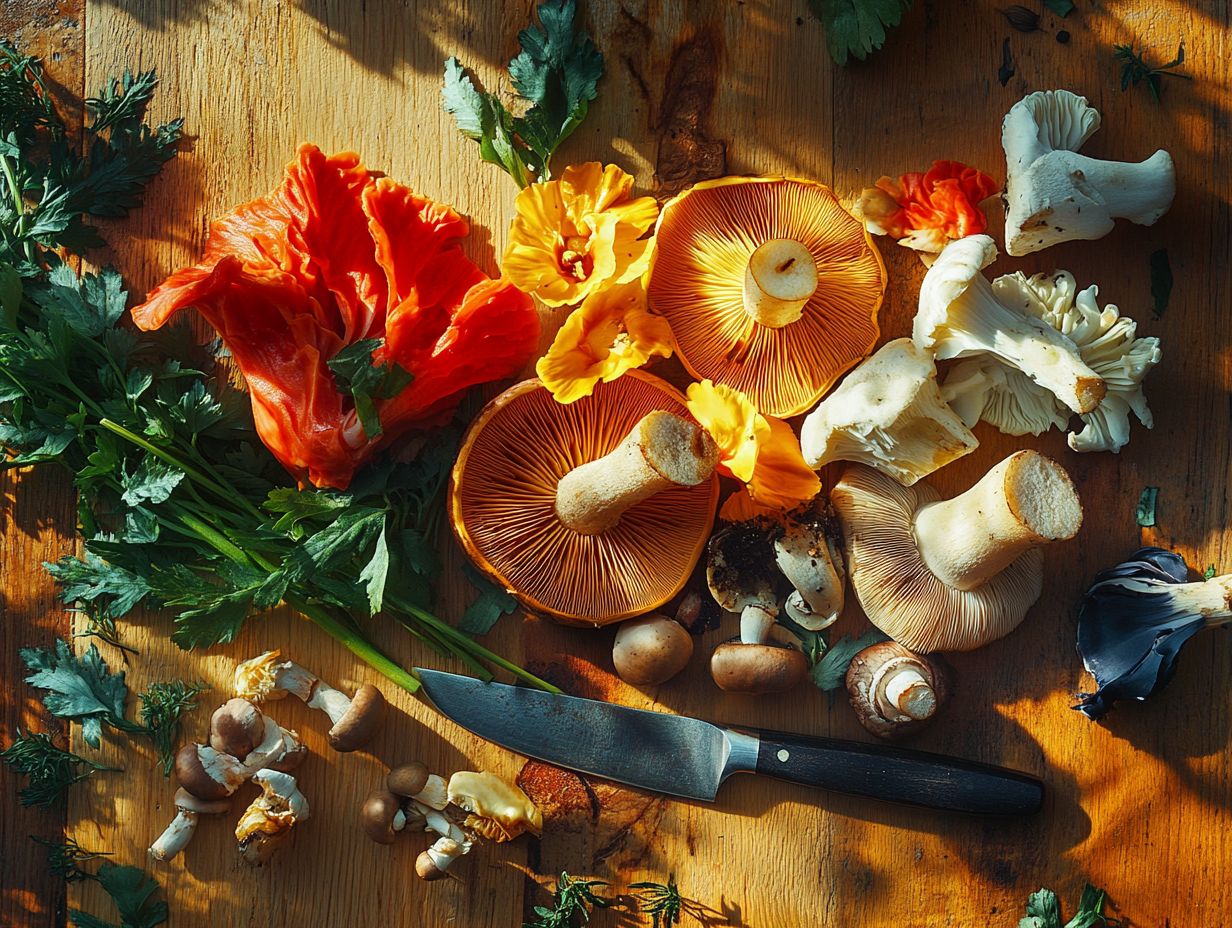
Eating wild fungi, especially various edible mushrooms, presents a wealth of health benefits that can elevate your well-being. These amazing mushrooms supercharge your immune system and provide essential nutrients, including antioxidants and beta-glucans (a type of fiber that can help your immune system), supporting overall health and possibly aiding in the prevention of chronic diseases when seamlessly integrated into a balanced diet.
Many wild mushrooms are also rich in vitamin D a vital nutrient for bone health and immune function making them an exceptional addition to your healthy eating plan.
Research shows that mushrooms like shiitake and reishi can enhance immune response while potentially reducing inflammation levels in your body. A study published in the Journal of Medicinal Food underscores that these mushrooms contain polysaccharides capable of stimulating immune cells, reinforcing their critical role in disease prevention.
Lion s mane, celebrated for its cognitive benefits, has shown promising results in promoting nerve growth factor, which is essential for brain health.
The antioxidants found in mushrooms play a crucial role in combating oxidative stress, further supporting longevity and overall vitality. Experts recommend incorporating a diverse array of mushrooms into your daily meals to fully harness these potential health advantages.
Get out there and discover the world of wild mushrooms your taste buds will thank you!
How Can One Safely Identify and Harvest Wild Mushrooms?
Safely identifying and harvesting wild mushrooms requires a keen eye and understanding of their features. This knowledge helps you collect edible mushrooms and avoid toxic ones.
As a beginner, refer to reliable field guides or consult local experts. Many mushrooms look similar, so it’s crucial to know their habitat and growth patterns.
Familiarizing yourself with characteristics like cap shape and gill structure is vital. These traits help differentiate safe options from harmful ones.
Pay attention to the ecological context; some mushrooms thrive in specific environments. Recognizing these nuances will aid your identification efforts.
Safety should always be your top priority. It’s better to err on the side of caution, as even a single mistake can have serious consequences. Consulting knowledgeable individuals before consuming any wild mushrooms is essential.
What Are the Potential Risks of Eating Wild Mushrooms?
Many wild mushrooms are nutritious, but you must recognize the risks involved. Mushroom toxicity can lead to serious health issues.
Some mushrooms look like edible ones, so being informed is essential. Research and seek expert guidance to minimize risks.
Experts in mushroom study often stress that the line between safe and toxic mushrooms can hinge on minute details, such as gill structure or spore color. For example, the notorious Death Cap mushroom can easily be mistaken for the innocuous Paddy Straw mushroom, leading to numerous poisonings.
Local foraging clubs frequently host events where seasoned mushroom hunters share their expertise. These gatherings emphasize the importance of understanding local ecosystems, as many safe varieties thrive alongside their hazardous look-alikes.
Without honing your identification skills and respecting nature’s complexity, you risk your health and safety in the pursuit of wild culinary treasures.
How Can One Incorporate Wild Mushrooms into Their Diet?
Incorporating wild mushrooms can be an exquisite adventure! These flavorsome delights enhance your meals with impressive nutritional benefits.
Whether you saut them or use them in pasta sauces, wild mushrooms add depth to your cooking. Let your creativity shine!
Experimenting with varieties like chanterelles or porcini opens up a tantalizing world of possibilities in your kitchen. Imagine enhancing creamy polenta with their savory depth or tossing saut ed mushrooms into a salad for an earthy note.
Each preparation method roasting, grilling, or dehydrating can highlight their intriguing textures and flavors. Embrace the opportunity to explore delightful pairings with garlic, herbs, and artisanal cheeses, transforming your culinary experience into something truly unforgettable.
What Are Some Delicious Recipes Using Wild Mushrooms?
Creating delicious recipes with wild mushrooms can turn your cooking into an exciting culinary adventure, especially when you know the top 10 wild plants everyone should recognize.
These flavorful fungi offer endless possibilities for innovative dishes that will truly tantalize your taste buds. From creamy wild mushroom risotto to savory stir-fries and delightful appetizers, the unique flavors of wild mushrooms can elevate any meal.
You can easily incorporate these edible gems into various cuisines, showcasing their versatility and enhancing your overall dining experience.
With many wild mushroom varieties at your fingertips think chanterelles, morels, and porcini dive into a world of exciting textures and flavors! Each type brings its own distinct characteristics, making it essential for you to understand the unique qualities that wild mushrooms offer.
If you’re looking to experiment, consider simple techniques like saut ing or grilling, or even tossing them into soups; these methods can dramatically transform a dish.
This collection of recipes highlights the rich savory taste of mushrooms and ensures that every step of preparation is straightforward and enjoyable.
You’ll find yourself fully appreciating the art of mushroom cooking as you embark on this flavorful journey.
What Are Some Common Myths About Eating Wild Fungi?
Despite the growing allure of foraging and cooking with wild fungi, many myths and misconceptions cloud the consumption of wild mushrooms, often leaving enthusiasts feeling confused and cautious.
You might think that all wild mushrooms are poisonous, but the truth is, there s a whole array of edible varieties that can be safely savored with the right knowledge and identification skills.
It s essential to dispense these myths to encourage responsible foraging and foster an appreciation for the diverse world of wild edible mushrooms.
While it s true that some mushrooms can be harmful, many delicious varieties flourish in forests and meadows, just waiting to be discovered.
A common misconception is that you can spot toxicity by mere coloration or shape, but this is not always the case; some poisonous mushrooms bear a striking resemblance to their edible counterparts.
You may have heard that only seasoned foragers can accurately identify mushrooms, which may deter you from diving into this rewarding hobby.
However, with the right resources, anyone can learn to differentiate between safe and harmful varieties. Embracing accurate information not only enriches your foraging experience but also deepens your connection to nature.
Frequently Asked Questions
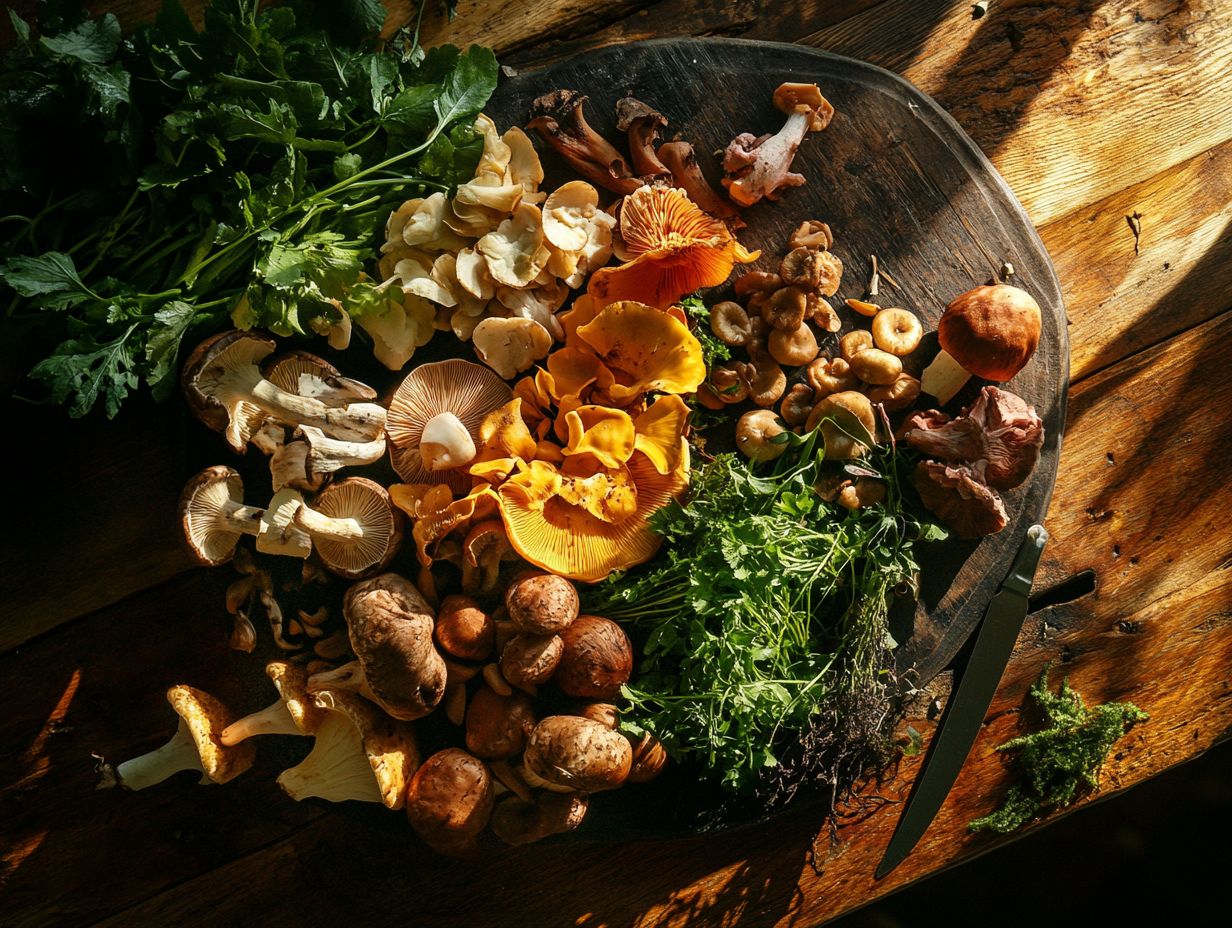
What are the top 10 wild fungi that are safe to eat?
- Morel
- Chanterelle
- Porcini
- Oyster
- Chicken of the woods
- Shiitake
- Puffball
- Black trumpet
- Hen-of-the-woods
- Lion’s mane
Are all wild fungi safe to eat?
No, some wild fungi can be poisonous. Always identify them correctly before eating.
What is the best way to harvest wild fungi for consumption?
The best way to harvest wild fungi is to carefully cut the mushroom at the base of the stem with a sharp knife. Leave some of the base attached to the ground to allow for future growth.
Are there any precautions to take when foraging for wild fungi?
Yes, always make sure to properly identify the mushroom before consuming it. Wear gloves and avoid touching your face or mouth while handling the mushroom. Only forage in areas that are free from pollution and pesticides.
Can wild fungi be cooked in the same way as store-bought mushrooms?
Yes, wild fungi can be saut ed, grilled, baked, or added to soups and stews. However, some may have a stronger flavor, so it is recommended to try a small amount first before cooking a large batch.
What are the health benefits of consuming wild fungi?
Wild fungi are a rich source of vitamins, minerals, and antioxidants. They boost the immune system, improve digestion, and provide anti-inflammatory benefits. They also have low calorie and fat content, making them a healthy addition to any diet.
Ready to explore the exciting world of wild mushrooms? Try cooking with them today or learn more about foraging!


